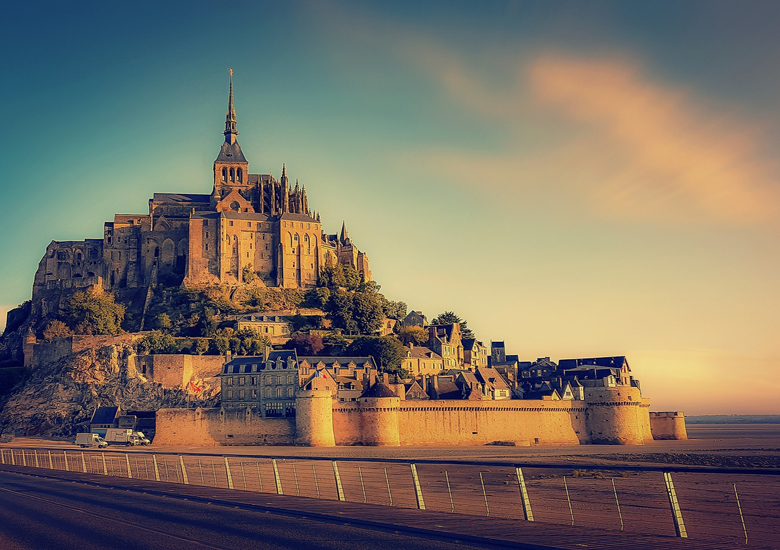Le Mont Saint-Michel Norman: Mont Saint Miche, English: Saint Michael’s Mount is an island commune in Normandy, France.
It is located about one kilometre (0.6 miles) off the country’s northwestern coast, at the mouth of the Couesnon River near Avranches and is 100 hectares (247 acres) in size. As of 2009, the island has a population of 44. The island has held strategic fortifications since ancient times and since the 8th century AD has been the seat of the monastery from which it draws its name. The structural composition of the town exemplifies the feudal society that constructed it: on top, God,
The abbey and monastery below, the great halls then stores and housing; and at the bottom, outside the walls, houses for fishermen and farmers. The commune’s position — on an island just 600 metres from land — made it accessible at low tide to the many pilgrims to its abbey, but defensible as an incoming tide stranded, drove off, or drowned would-be assailants. The Mont remained unconquered during the Hundred Years’ War a small garrison.
fended off a full attack by the English in 1433. The reverse benefits of its natural defence were not lost on Louis XI, who turned the Mont into a prison Thereafter the abbey began to be used more regularly as a jail during the Ancien Regime. One of France’s most recognizable landmarks, visited by more than 3 million people each year, Mont Saint-Michel and its bay are on the UNESCO list of World Heritage Sites. Over 60 buildings within the commune are protected in France as monuments historiques.
Access : Coordinates: / 48.636, -1.5114 / Public transport : There is no direct train line between Paris and Mont Saint-Michel, but it is possible to travel to Pontorson by train and then complete the bus journey. The best option is to take the TGV train station Montparnasse to Rennes or Dol-de-Bretagne. The Rennes – Mont-Saint-Michel and Dol-de-Bretagne – Mont-Saint-Michel express line from the regional council will take you to Mont Saint-Michel. Five round trips are offered during the day and are in correspondence with TGVs from Paris. the connection is not assured from Rennes check it before leaving. Also note that traffic can be very dense around the mount (there is only one road). It is possible that you will miss your train. During the summer, the wait at the exit of the mountain can reach an hour or more. The bus stop is located directly at the “north” exit of Rennes station, at the bus station on the right. In Dol-de-Bretagne, the bus parks in front of the exit of the station./ By taxi :
Taxis are expensive for long trips, unless you can share the cost with other travelers. A one-way taxi ride from Mont Saint-Michel to Rennes costs around € 135. A cheaper option is to take a taxi to Dol de Bretagne and then take the train to Rennes where you can reach Paris./
By car
Driving is probably the easiest and cheapest way to visit Mont Saint-Michel, although the queue at the entrance to the parking lot is often long. From Caen, take the A84 motorway, exit at exit 34 towards Saint-Brieuc on the Nationale 175. It is then possible to go out to join the D43 which allows you to reach the mountain along the coast and follow signs to Mount. Or, you can get out of the 4 lanes by joining the D80.
From Paris, count 4 hours of road trip approx./
Atencion : Since 2012, it is no longer possible to drive to the foot of the mountain. A huge parking lot has been built on the continent (€ 12-13 per car) and access to the mountain is either on foot via the new footbridge (about 2.5 km) or via one of the free shuttles (bus ) or paying (coaches) which ensure the connection regularly between 7:30 am and midnight. However, the parking is relatively distant (about 800 m) from the departure point of the shuttles and on arrival, there are a few hundred meters to walk to the entrance.
Attempting to reach Mont Saint-Michel from another road than the road can be dangerous. It is not uncommon for tourists to find themselves surrounded by the tide, while mud and quicksand surround the island. If you decide to try the crossing, have an experienced guide accompany you and check the tide schedule. In addition, do not attempt the crossing when the Couesnon dam releases its water.
Go next : Beauvoir, Manche / Dol de Bretagne

